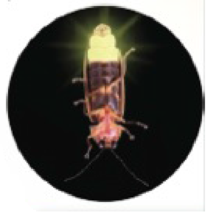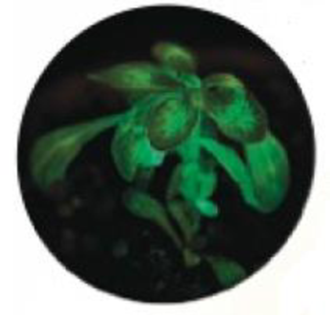
Concept explainers
You may have seen the almost magical glow of fireflies. but did you know that plants can be bioengineered to glow in t he dark, too? The firefly’s natural glow comes from specialized cells in their abdomens that are bioluminescent. meaning that they produce light from biological reactions. These cells are rich in both ATP and the fluorescent chemical luciferin (L. lucifer, light-bringer). Luciferin and ATP serve as substrates for the enzyme luciferase. In the presence of oxygen, luciferase catalyzes a reaction that modifies luciferin, using the energy from ATP to boost electrons briefly into a higher-energy electron shell. As they fall back into their original shell, the electrons emit their excess energy as light.
If Plants Can Glow In the Dark?

Plants don’t naturally glow, but bioluminescence has been bioengineered into glowing Arabidopsis plants by the Glowing Plant team. First, the team ordered commercial luciferin and luciferase DNA synthesized from its computerized gene sequence. Then they implanted these genes into a special form of bacterial DNA that incorporates itself into plant cells. They used a “gene gun” to shoot microscopic particles coated with the modified bacterial DNA into masses of plant stem cells, which developed into plants. Choosing the brightest-glowing plants, the team harvested their seeds to grow new generations, whose seeds are now sold online to buyers who wish to brighten their abodes.

Want to see the full answer?
Check out a sample textbook solution
Chapter 6 Solutions
Biology
- Melvin Calvin and Andrew Benson determined the steps in the light-independent reactions of photosynthesis by exposing the green alga Chlorella to CO2 labeled with the radioisotope carbon 14. By looking at which compounds the C14 ended up in, they were able to identify all intermediates in this cyclic pathway. Why did they predict correctly that the same set of intermediates would be formed in the light reaction in land plants?arrow_forwardxygen Production Your experimental team has gathered data on the rate of a plant's photosynthesis, measured by oxygen production, as the light intensity was increased. The graph below was created from your gathered data. Note: Diagram 4 may also be helpful in answering the questions. Use the information in order to answer questions #28 -31. Diagram 7: Rate of Photosynthesis with increasing light intensity 200 - Pmax 150 - 100 - 50 50- -100 100 200 300 400 500 600 700 Light Intensity (arbitrary units) Glossary: 1. Pmax: The maximum pressure of oxygen gas. 2. Arbitrary units: The use of this term mean the graph is not using specific units as labels. Light intensity could be measured in lumens and oxygen production could have been measured in mm of Hg Select the best explanation for the oxgen production leveling off as the light increases in intensity. More light reduces the activity of the chlorophyll by breaking the pigment down. More light prevents water from getting to the leaf cells…arrow_forwardWhat properties of photosynthetic pigments allow pigments to absorb light of only certain wavelengths? Select all that apply. Some pigment molecules lack a light-trapping region. Light of any energy level can boost an electron of the pigment molecule to a higher energy level in order to be absorbed. Only light with the correct wavelength to boost an electron of the pigment to a higher energy level is absorbed. All pigment molecules possess a light-trapping region with a special structure that allows electrons to move freely between its atoms.arrow_forward
- IS THIS A GOOD BREAK DOWN? WHAT ELSE CAN I SHOULD I ADD? Briefly explain the light-dependent reactions of photosynthesis: where does this take place, what are the reactants and what is produced? Light-dependent reactions are used to convert light energy into chemical energy for use by the plants. Through the process of photosynthesis, the energy collected from the sun is broken down, along with water molecules, to produce NADPH and ATP. Light-dependent reactions Goal Convert light energy into chemical energy Location Chloroplasts—thylakoids Input Sunlight, H2O, NADP+, ADP Output NADPH, ATP, O2arrow_forwardThere are two photosystems involved in the light reaction of photosynthesis. Both take upenergy from the sun in the form of light.A. Where are the photosystems located and what is the name of the organelle? B. Where does the energy that the photosystems take up, go? Describe for eachphotosystem WHERE the energy ends up at the end of the light reactions. In otherwords, what products contain the energy from which photosystem at the end ofthe light reaction?arrow_forwardThe warmth of hot flowers attracts pollinators and helps broadcast the flowers’ (often foul) scent. Corpse flower stalks can reach 98°F, as warm as our bodies. The heat and foul odor both occur in pulses produced by the central stalk. How do these flowers get so hot? Amorphophallus and other heatproducing flowers have evolved mechanisms that disconnect cellular respiration from ATP synthesis. In most cells, cellular respiration uses about 40% of the energy in glucose to synthesize ATP, with the rest given off as heat (see Chapter 8). Hot flowers, on the other hand, synthesize very little ATP; instead, almost all of the energy in glucose is released as heat, causing the flower to warm up. Besides the promise of carrion, what other features have flowers evolved that attract animal pollinators?arrow_forward
- Cells are open systems that exchange matter and energy with their surroundings. Which of the following best explains why plant cells require sunlight to make organic compounds, according to Gibbs’s theory of free energy? The photosynthetic reaction releases free energy to the surroundings. The photosynthetic reaction’s free energy is in equilibrium. The reactants of photosynthesis have less free energy than the products. The change in free energy (∆G) of the photosynthetic system is less than zero.arrow_forwardBacterium Y is photosynthetic. You want to decrease the ability of Bacterium Y to produce glucose through photosynthesis. Explain how you could manipulate the light reactions of photosynthesis to decrease glucose production during the dark reactions in Bacterium Y. Include the name of the pathway that makes glucose during the dark reactions, which/how molecules from the light reactions are used in this pathway, and what specific steps of this pathway would be affected by your manipulations.arrow_forwardWhich of the following statements is FALSE? Group of answer choices: - Plastoquinone has a higher reduction potential than plastocyanin. - Water is the ultimate electron donor. - Proton gradient is created in the light phase of photosynthesis wherein the pH in the stroma is higher than in the lumen. - Photosystem II has chlorophylls in its reaction center that has maximum light absorption at 680 nm.arrow_forward
- If Photosystem I is inhibited, will H+ still be pumped into the thylakoid space? No, because the electron flow would be stalled Yes, because ATP synthase would still pump H+ Yes, because Photosystem II is after the Electron Transport Chain O No, because Photosystem I is before the Electron Transport Chain You are working at a biotech company that is studying new enzymes from plant cells to produce biofuels. You know that one of the substrates of the enzyme is the hydrocarbon tails of fatty acids. Which amino acid might you expect to find in the active site of the enzyme? O glutamic acid O tryptophan serine histidine If you modified the tail of chlorophyll to be polar, which of the following would you expect to happen to light energy? Light would not be absorbed by chlorophyll Light would be absorbed but the energy would be lost as fluorescence/heat since the chlorophyll would not interact with the membrane reaction center O Light would be absorbed and the electron would remain in an…arrow_forwardWhich of the following statements about the light reactions of photosynthesis are correct? 1. Absorption of light does one thing: it makes chlorophyll easier to oxidize. 2. In PSII, the rate of damage to the D1 protein can never exceeds the rate of repair. 3. Electron transport is spontaneous (exergonic) as electrons move from P680* to P700+. 4. Compared to anoxygenic photosynthesis, in oxygenic photosynthesis less light needs to be absorbed to reduce NADP+. A. 1,2 and 3 B. 1 and 3 C. 2 and 4 D. 4 only E. All of 1,2,3 and 4 are correctarrow_forwardIf you could replace all of the plant ATP synthase with ATP synthase enzymes from animal cells, oriented such that the Fo complex was in the thylakoid membrane with the open channel facing the thylakoid space, and the F1 complex was present in the stroma, how would this affect the ability of photosystem II to generate ATP? Assume that the animal cell ATP synthase functions normally in the chloroplast after replacement.arrow_forward
